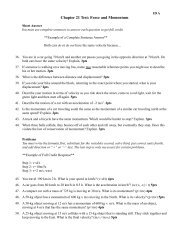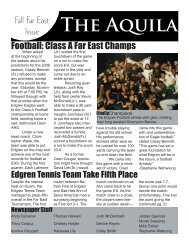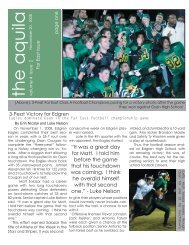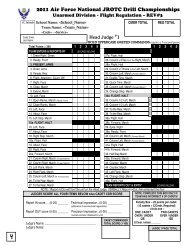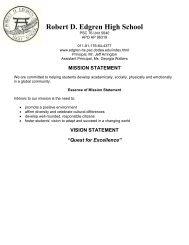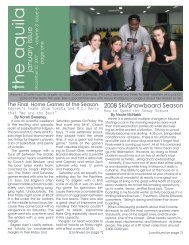AFJROTC Student Workbook CH03_Lesson_2 - Edgren High ...
AFJROTC Student Workbook CH03_Lesson_2 - Edgren High ...
AFJROTC Student Workbook CH03_Lesson_2 - Edgren High ...
Create successful ePaper yourself
Turn your PDF publications into a flip-book with our unique Google optimized e-Paper software.
<strong>CH03</strong>_LE1 6/28/05 4:19 PM Page 166<br />
Play it Safe with Food<br />
Know how to prepare, handle, and store food safely. Part of wise nutrition involves<br />
making sure that foods are safe from harmful bacteria and other contaminants. Doing<br />
so reduces the risk of foodborne illness, which is a sickness that results from eating<br />
food that is not safe to eat.<br />
• Clean hands, food-contact surfaces, fruits, and vegetables. To avoid spreading<br />
bacteria to other foods, meat and poultry should not be washed or rinsed.<br />
Separate raw, cooked, and ready-to-eat foods while shopping, preparing, or storing.<br />
Cook meat, poultry, and fish to safe internal temperatures to kill microorganisms.<br />
• Chill perishable foods promptly and thaw foods properly.<br />
Nutrition Labeling<br />
Perhaps you have noticed that all packaged foods carry a label titled “Nutrition<br />
Facts.” These labels provide valuable information for making healthful food choices.<br />
Food labels compare products to the Percent Daily Value. This figure is the percent of<br />
the recommended daily amount of a nutrient provided in a serving of food. The<br />
Percent Daily Value is based on an intake of 2,000 calories per day. Understanding<br />
how to read a food label, like the one shown in Figure 3–7, can help you select<br />
nutritious foods and balance your eating pattern.<br />
FIGURE 3–7.<br />
WHAT THE FOOD<br />
LABEL TELLS YOU<br />
Food labels provide important<br />
nutritional information that<br />
can help you make sensible<br />
food choices.<br />
A<br />
B<br />
C<br />
The nutrient content of the<br />
food is calculated according<br />
to its serving size. The serving<br />
size on the food label may<br />
differ from sizes shown on<br />
the Food Guide Pyramid.<br />
The amount of total fat in one<br />
serving is listed, followed by<br />
the amount of saturated fat.<br />
The calories from fat are shown<br />
to the right of the total calories<br />
per serving.<br />
Major vitamins and minerals<br />
are shown, along with their<br />
Percent Daily Value.<br />
Nutrition Facts<br />
Serving Size 1 /2 cup (114g)<br />
Servings Per Container 4<br />
Amount Per Serving<br />
Calories 90 Calories from Fat 30<br />
% Daily Value*<br />
Total Fat 3g 5%<br />
Saturated Fat 0g 0%<br />
Cholesterol 0mg 0%<br />
Sodium 300mg 13%<br />
Total Carbohydrate 13g 4%<br />
Dietary Fiber 3g 12%<br />
Sugars 3g<br />
Protein 3g<br />
Vitamin A 80% • Vitamin C 60%<br />
Calcium 4% • Iron 4%<br />
* Percent Daily Values are based on a 2,000<br />
calorie diet. Your daily values may be higher<br />
or lower depending on your calorie needs:<br />
Calories 2,000 2,500<br />
Total Fat Less Than 65g 80g<br />
Sat Fat Less Than 20g 25g<br />
Cholesterol Less Than 300mg 300mg<br />
Sodium Less Than 2,400mg 2,400mg<br />
Total Carbohydrate 300g 375g<br />
Dietary Fiber 25g 30g<br />
Calories per gram:<br />
Fat 9 • Carbohydrate 4 • Protein 4<br />
D<br />
E<br />
A<br />
Major nutrients are<br />
listed in milligrams<br />
(mg) or grams (g)<br />
and as a percentage<br />
of the recommended<br />
amount for a person<br />
consuming 2,000<br />
calories per day.<br />
Dietary fiber and<br />
sugar are given<br />
under Total<br />
Carbohydrate.<br />
Information provided<br />
on the lower part of<br />
the Nutrition Facts<br />
panel is the same<br />
from product to<br />
product. It contains<br />
advice about the<br />
amounts of certain<br />
nutrients that should<br />
be eaten each day.<br />
Amounts are given<br />
for both a 2,000-<br />
calorie and a 2,500-<br />
calorie diet.<br />
166 CHAPTER 3 BE HEALTH SMART



